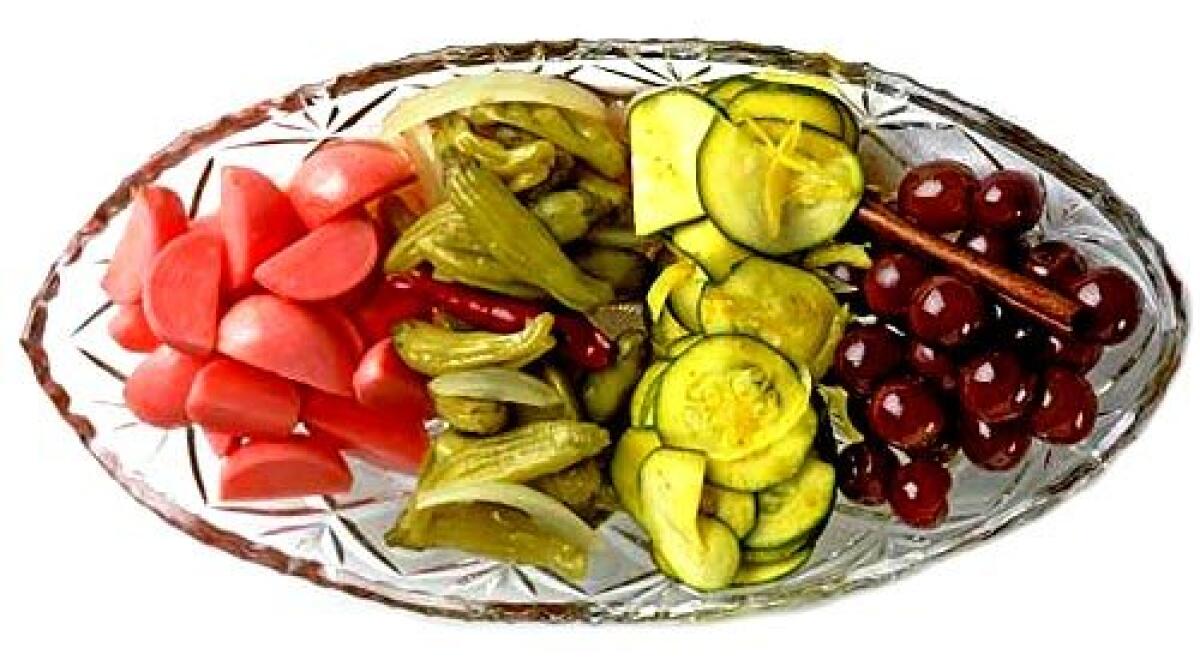Pickles add punch to summertime meals

WHERE have all the pickles gone?
It wasnât so long ago that every well-dressed American dinner table was bejeweled with an assortment of them -- emerald green tomatoes, ruby red beets and opalescent pearl onions, as well as less glamorous (though certainly no less delicious) okra, mushrooms and watermelon rind. The pickle tray was a standard part of a Sunday supper.
Nowadays, almost the only pickle youâll find is cucumber. And while thereâs nothing wrong with your basic bread-and-butter, half-sour or dill, there are so many other possibilities to explore.
What about radishes, for example, pickled pink, with a refreshing sweet-tart bite to match their crisp texture? Or tangy peppers, yellow turmeric-stained zucchini or even surprisingly savory pickled grapes?
These are more than mere curiosities. They are perfect for the way we eat in the summertime. A bite of crisp tart pickle is as cooling as an evening breeze.
Their acidity cuts right through the smoke and richness of grilled meat, just as their sweetness and spiciness balance and complement it. Do you doubt it? Think about ketchup, which, when broken down to its basics, is really nothing more than a pureed pickle of ripe tomatoes.
Pickles also make great antipasti. Like olives (technically, yet another kind of pickle), their punchy flavors prime the palate for the bigger dishes to come.
But while many traditional pickles take weeks of aging to mellow and mature, there are very good pickles you can make in a single day.
You donât need fancy equipment or advanced cooking skills. If you can slice a vegetable and boil water, you can make a pickle.
The only gadget I used was a Japanese tsukemono-ki, a plastic pickle press that is available at Asian markets for around $20. Itâs a simple contraption: Put the salted vegetables in the bottom, then put on the lid and screw down the plate to press the vegetables flat against the bottom, expressing their moisture.
Using this seems to keep the finished pickles crisper, but even though a pickle press is a handy tool, it is by no means a necessity.
First, a little definition: A pickle is a fruit or a vegetable that is preserved through acidity. Because most harmful bacteria have a hard time surviving in a low-pH environment, pickling was an important part of preserving the harvest in the days before refrigeration.
There are two main ways of making a pickle. The first is by salting the food to draw out its moisture, which is rich in sugars that are fermented by naturally occurring bacteria to create lactic acid (the same acid that preserves so many of our favorite foods, including yogurt, cheeses and salumi).
This is how pickles as diverse as sauerkraut and olives are made. The flavors created are complex, but the time required is long -- weeks or even months.
A simpler form of pickle can be made simply by soaking food in an acid liquid, in most cases, a flavored vinegar mixture. All thatâs necessary is to first soften the fruit or vegetable. This can be done either by blanching it briefly in boiling water or by salting it for an hour or two.
The latter has the added benefit of slightly dehydrating the fruit or vegetable, which allows it to absorb more of the moisture from the vinegar mixture, saturating it with flavor. As you might expect, this technique allows plenty of room for the creative cook to mess around.
Vinegar choices
THOUGH ordinary, white distilled vinegar can be used for most pickles, you can get a different effect by substituting apple cider or Asian rice vinegar. Similarly, donât feel bound to the common pickling spices of mustard, peppercorns, dill and their brethren. Try using cloves, allspice or cinnamon, fresh ginger or dried chiles.
The two ingredients youâll want to include in some measure are a little salt to bring out the flavor of the vegetable, and some sugar to soften the harsh edges of the vinegar.
Though the flavoring of these brines is up to you, be careful that you have at least as much vinegar as other liquids (and note that apple cider does not have the same acidity as apple cider vinegar). Because commercial vinegarâs standard acidity is 5%, thatâll ensure that the finished brine is at least a safe 2.5%.
However you flavor the pickle, there is likely to be a bit of a learning curve when you start experimenting. Soon, though, youâll develop a palate for tasting pickles early. What may initially seem a little dull and one-dimensional can develop into something very delicious as herbs and spices contribute their flavor and the pickle mellows and deepens.
The first couple of times you experiment, donât go overboard with the spicing. Give the pickles a day to develop and see how you like them before adjusting the recipe for the next attempt.
A good way to start pickling is by trying some reliable recipes from favorite cookbooks.
One classic on pickles, jams and jellies is âFine Preserving,â by Catherine Plagemann. Originally published in the 1960s, it was largely forgotten until it was reissued in the 1980s with annotation by none other than M.F.K. Fisher.
Though the idea of pickled grapes sounds unusual, Fisher said it was one of her favorite recipes in the book. Intrigued, I had to give it a try. Itâs spectacular. The addition of just the tablespoon of minced onion lends a surprising savory dimension to the brine. (Oddly, Fisher says she left out the onion when she made it. . . . Maybe she is fallible after all.)
Zucchini easy
MY NEXT attempt was just as successful. If youâve ever eaten a hamburger at Zuni CafĂŠ in San Francisco (or at Beniciaâs Union Hotel before that), you may well have tried the chartreuse zucchini pickles that come as a standard accompaniment.
And if youâve tried them, you may well have asked the waitress to bring out a second helping. They couldnât be easier to make, and doing them yourself means never having to beg again.
Emboldened by these successes, I tried a couple of pickles of my own invention. I love torshi, the Middle Eastern turnip pickles, and I wondered whether you couldnât get the same texture from a radish, but with a slightly different flavor.
Turns out, radish pickles are every bit as crisp, but with a subtle spice underneath.
I tried these a number of different ways -- with white vinegar and rice vinegar, spiced with cloves and flavored with peppercorns and mustard seed -- before settling on this version, which will now become a standard part of my appetizer repertoire. They are absolutely delicious served with sliced salumi.
Finally, I wondered whether you couldnât pickle Japanese shishito peppers -- commercial pickled peppers are usually dull, and small wax peppers can be hard to find, even at farmers markets.
Hallelujah, itâs a snap, one of the easiest pickles I made. Simply cut a couple of slits in each pepper to allow the heat and the brine to penetrate, blanch them in boiling water for about a minute, then cover them with warm vinegar spiced with dried chiles, oregano and onion. The pickles -- crisp, sweet and tart -- will be ready to eat in eight hours or so.
All of these pickles can be canned, if you like, following the standard instructions. But theyâll keep their texture and flavor for weeks simply stored in the refrigerator.
Of course, delicious as they are, itâs doubtful theyâll be around anywhere near that long.
More to Read
Sign up for The Wild
Weâll help you find the best places to hike, bike and run, as well as the perfect silent spots for meditation and yoga.
You may occasionally receive promotional content from the Los Angeles Times.











